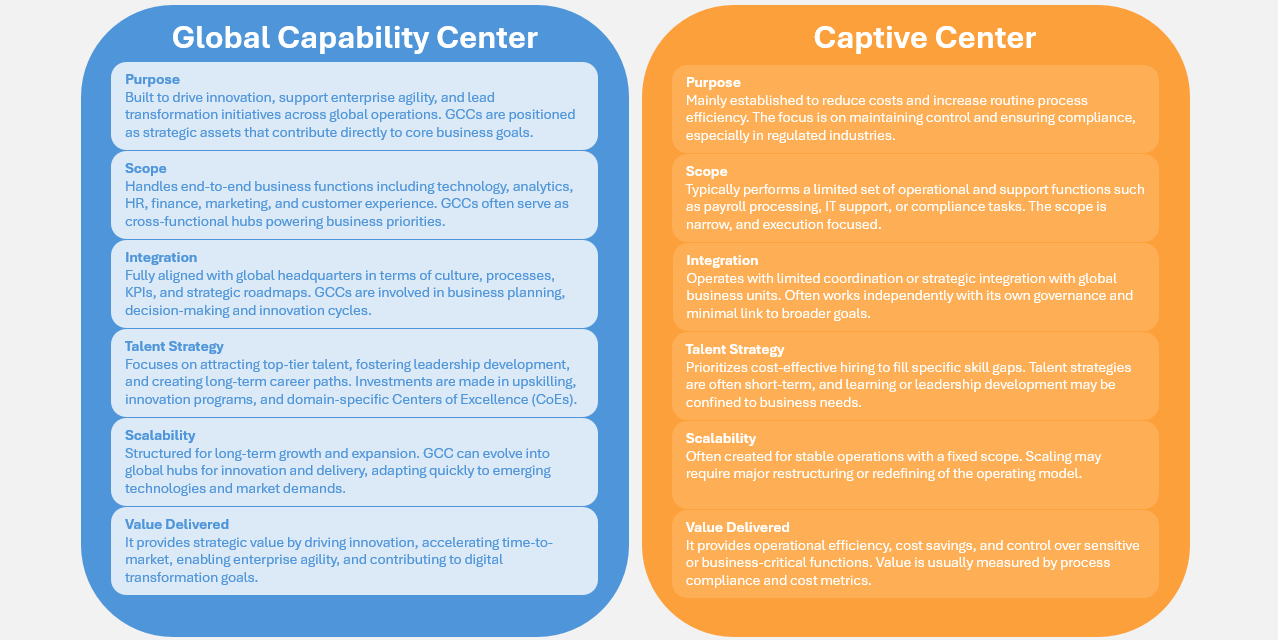GCC vs. Captive Center: Key Differences Explained
Published on
As global enterprises aim to scale operations, foster innovation, and optimize costs, choosing the right delivery model becomes a critical strategic decision. Among the most widely adopted structures are Global Capability Centers (GCCs) and Captive Centers. While both are fully owned offshore entities, they vary greatly in purpose, scope, and the value they bring to the business.
The terms ‘Global Capability Center’ and ‘Captive Center’ are central to conversations around how companies leverage technology, talent, and infrastructure for long-term growth and competitive advantage. Initially established for operational and support functions, these offshore centers have evolved significantly. GCCs have emerged as strategic hubs that drive innovation, speed up digital transformation, and provide high-value, knowledge-based services essential to business success.
A Global Capability Center (GCC) functions as a strategic offshore extension of a global enterprise, offering services across technology, finance, HR, analytics, and digital transformation. These centers are deeply embedded within the parent company’s global operations, enabling agility, innovation, and enterprise-wide impact. With more than 1,800 GCCs in India alone, many house Centers of Excellence (CoEs), invest in talent development, and lead initiatives in AI/ML, customer experience, and product development making them key engines of strategic growth.
In contrast, a Captive Center is designed to handle a narrower range of operational tasks, such as IT support, finance, HR, and compliance. These centers prioritize cost-effectiveness and operational control, operating largely as independent support units with minimal integration into the company’s broader strategy. While they remain essential in regulated industries for oversight and process consistency, Captive Centers focus on stability and risk mitigation rather than innovation and transformation.
GCC vs. Captive Center: Key Differences
While both are fully owned by the parent company and located offshore, their goals, integration, and impact vary greatly.

Which Model Is Right for Your Organization?
Your choice between a GCC vs. Captive Center depends on several factors:
When to Choose a Captive Center:
Need for Stringent Oversight of Sensitive Operations
You require direct oversight and control over sensitive or highly regulated functions, such as financial reporting, compliance management, confidential data handling, or intellectual property protection.
Focus on Operational Efficiency Over Innovation
Your primary objective is to achieve cost savings and operational efficiency—rather than to pursue innovation or develop new capabilities. This may include streamlining transaction processes, standardizing routine administrative tasks, or centralizing support services.
Early Phase of Global Expansion with a Preference for Narrow Scope
You are in the initial stages of expanding internationally and prefer to start with a focused set of responsibilities. For example, you may limit activity to functions like payroll processing, IT maintenance, accounts payable, or customer service before considering broader or more strategic operations.
Captive Centers are common in sectors like banking, where data confidentiality and regulatory compliance are critical.
When to Choose a Global capability center:
Focus on Driving Innovation, Agility, and Change
Your organization aspires to be a catalyst for innovation and rapid transformation. You seek to cultivate capabilities in areas such as digital transformation, product development, emerging technologies, business model innovation, and continuous process improvement.
Attracting and Retaining Top Global Talent
You prioritize access to high-caliber talent, aiming to build multidisciplinary teams with deep expertise in domains like artificial intelligence, cloud engineering, data science, cybersecurity, and customer experience design. Your goal is to create an environment that not only attracts but also retains the world’s best professionals.
Platform for Digital Scale and Global Collaboration
You need a structure that supports large-scale digital initiatives and seamless collaboration across geographies. This may include global project teams, cross-functional innovation squads, or shared services hubs that enable end-to-end digital transformation and accelerated go-to-market strategies.
GCCs work best for mature enterprises looking to build global operating models aligned with business strategy.
Final Thoughts
Captive centers excel at delivering focused, cost-efficient expertise in specific functions, whereas Global Capability Centers provide a broader platform for rapid innovation and multifaceted capability building.
That’s where Global Capability Centers excel. At ANSR, we’ve helped over 175+ global companies build and scale high-performing GCCs in talent-rich markets like India. We bring expertise to help you get it right, regardless of transitioning from captive model or starting from scratch.




